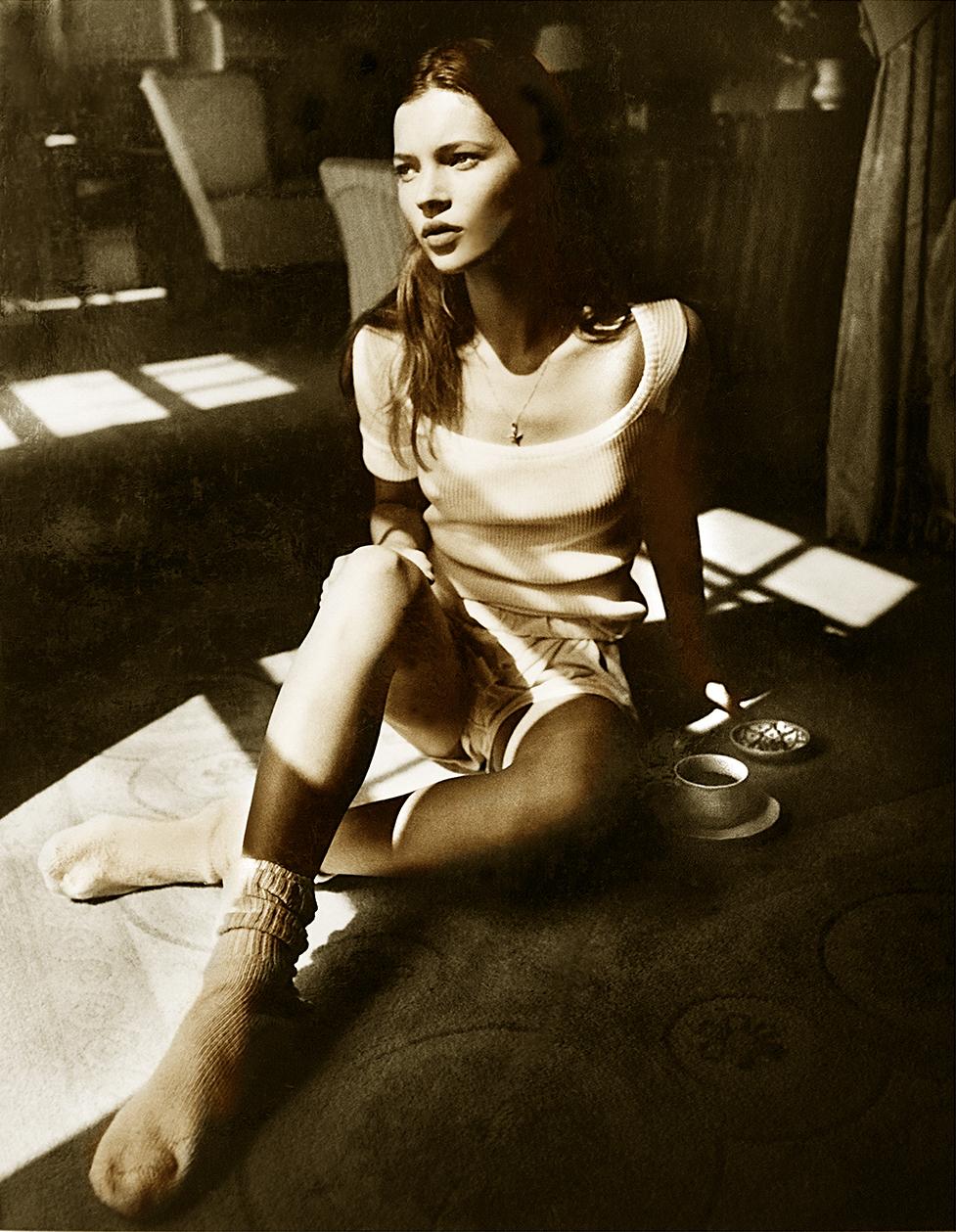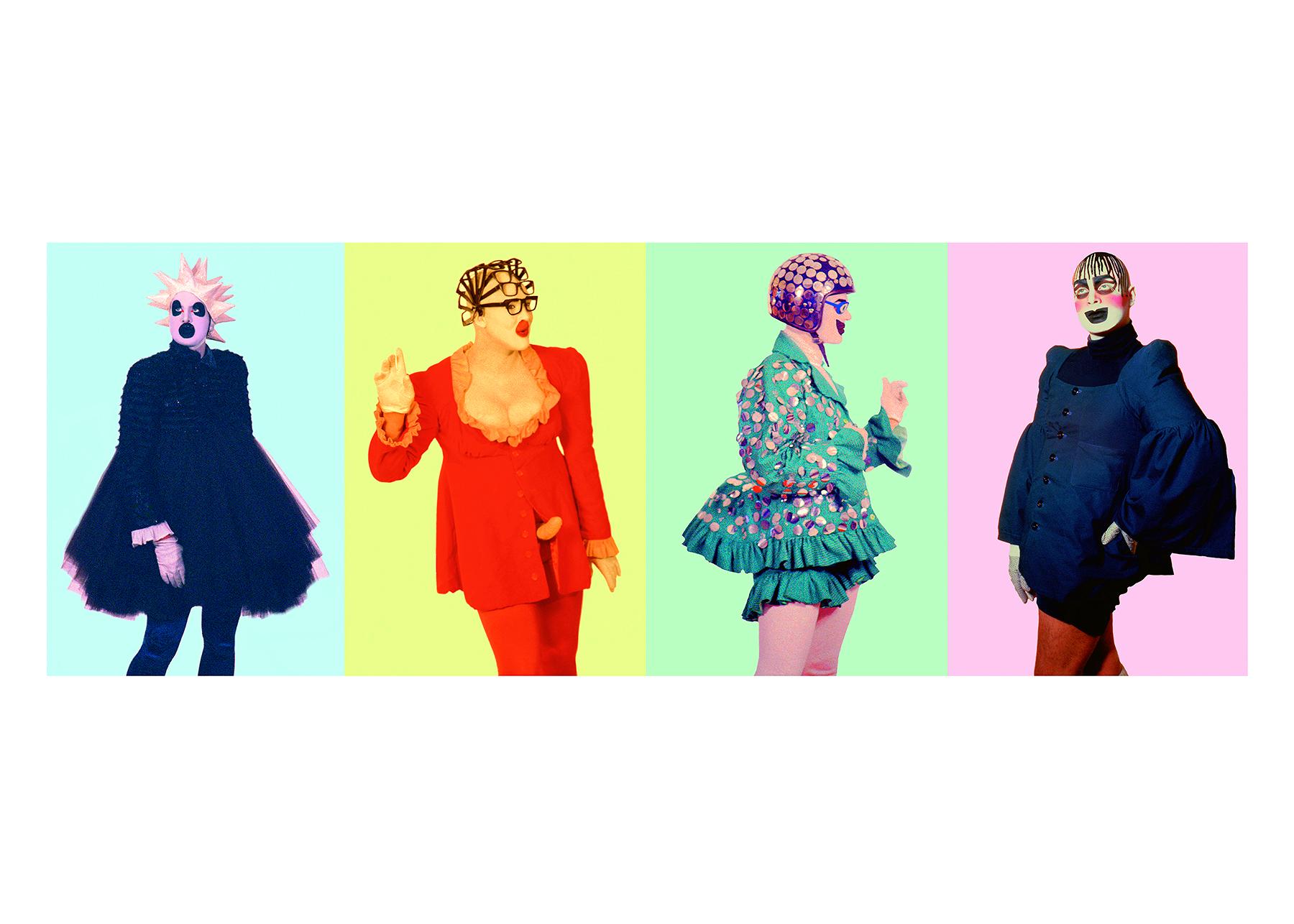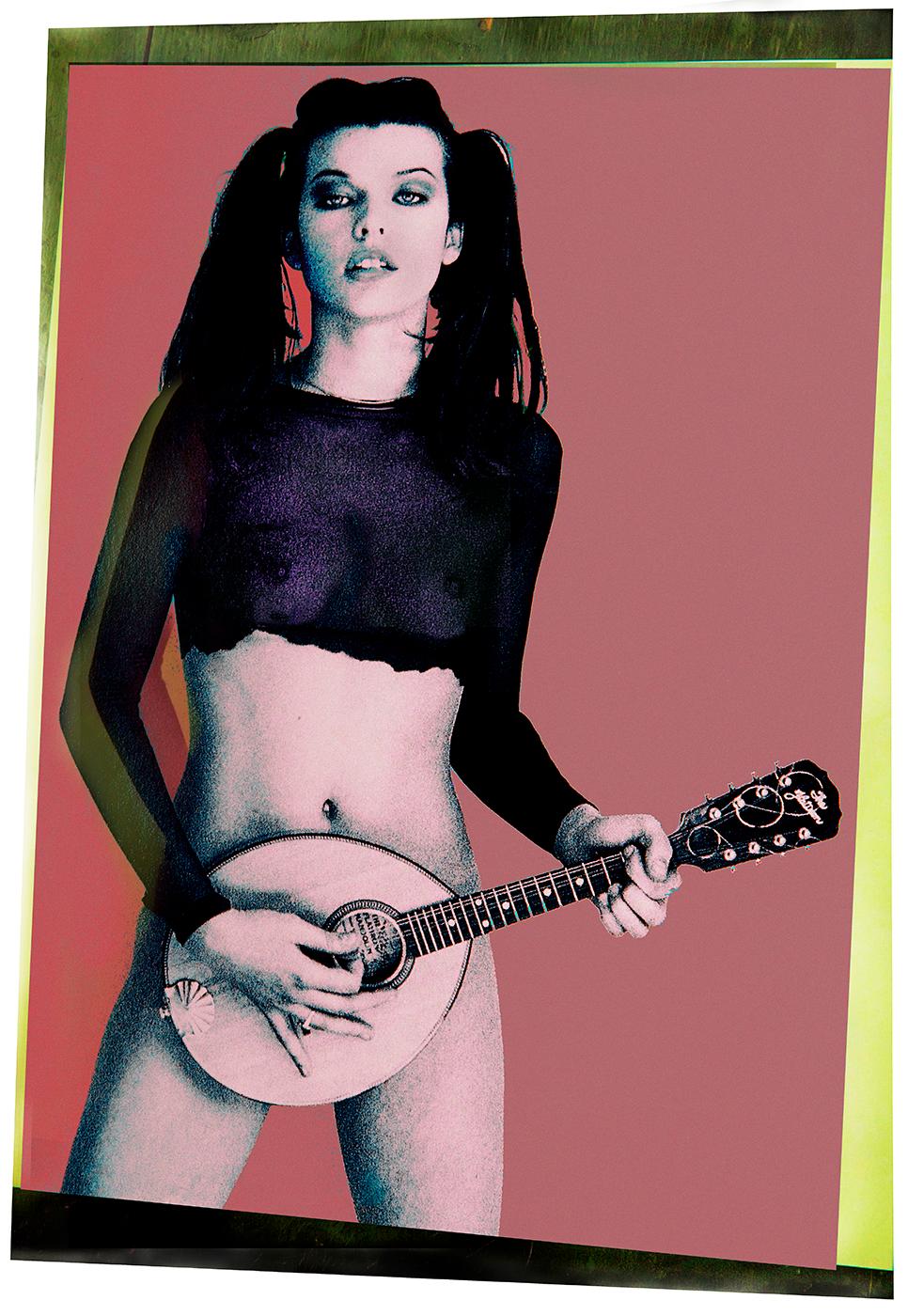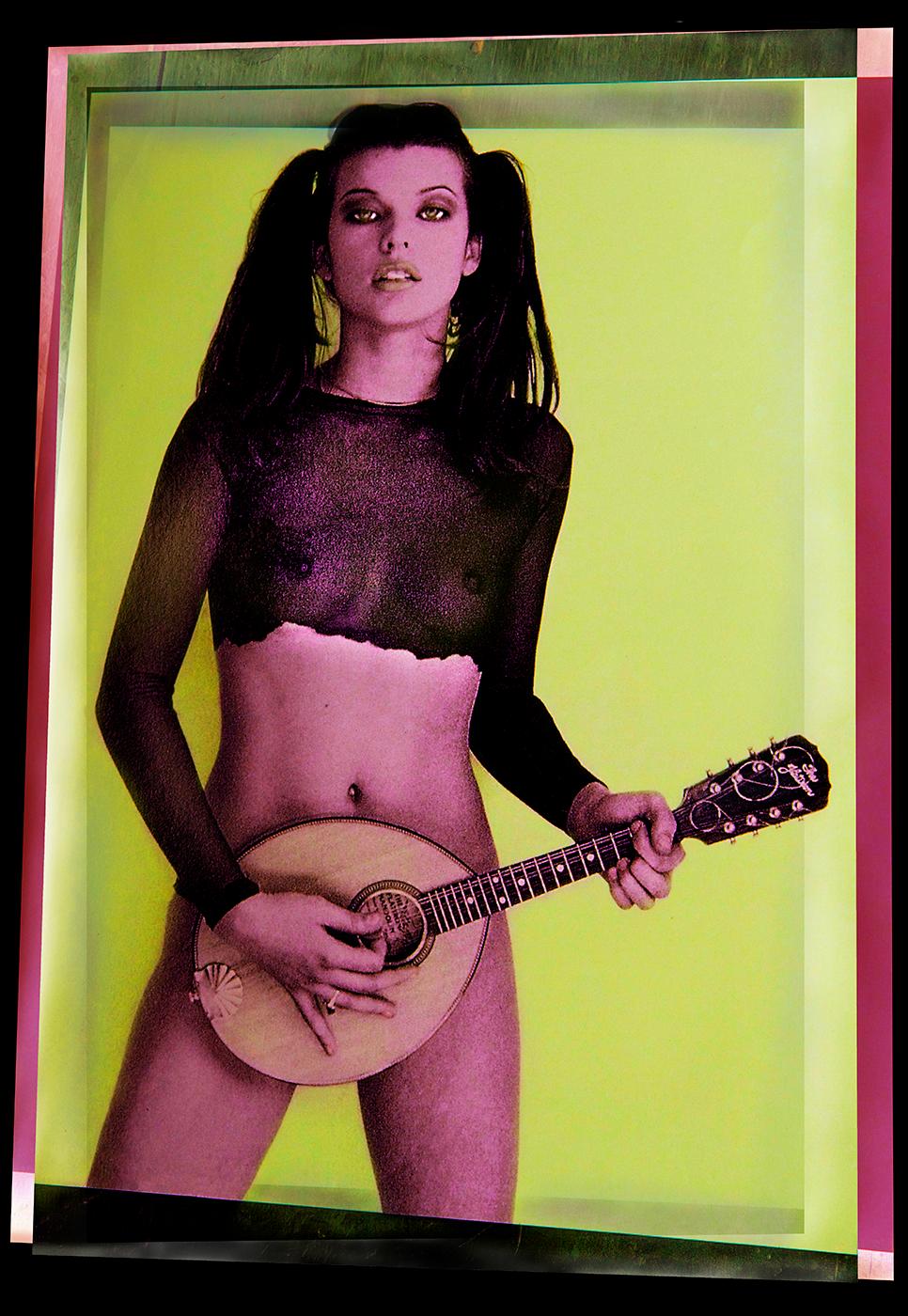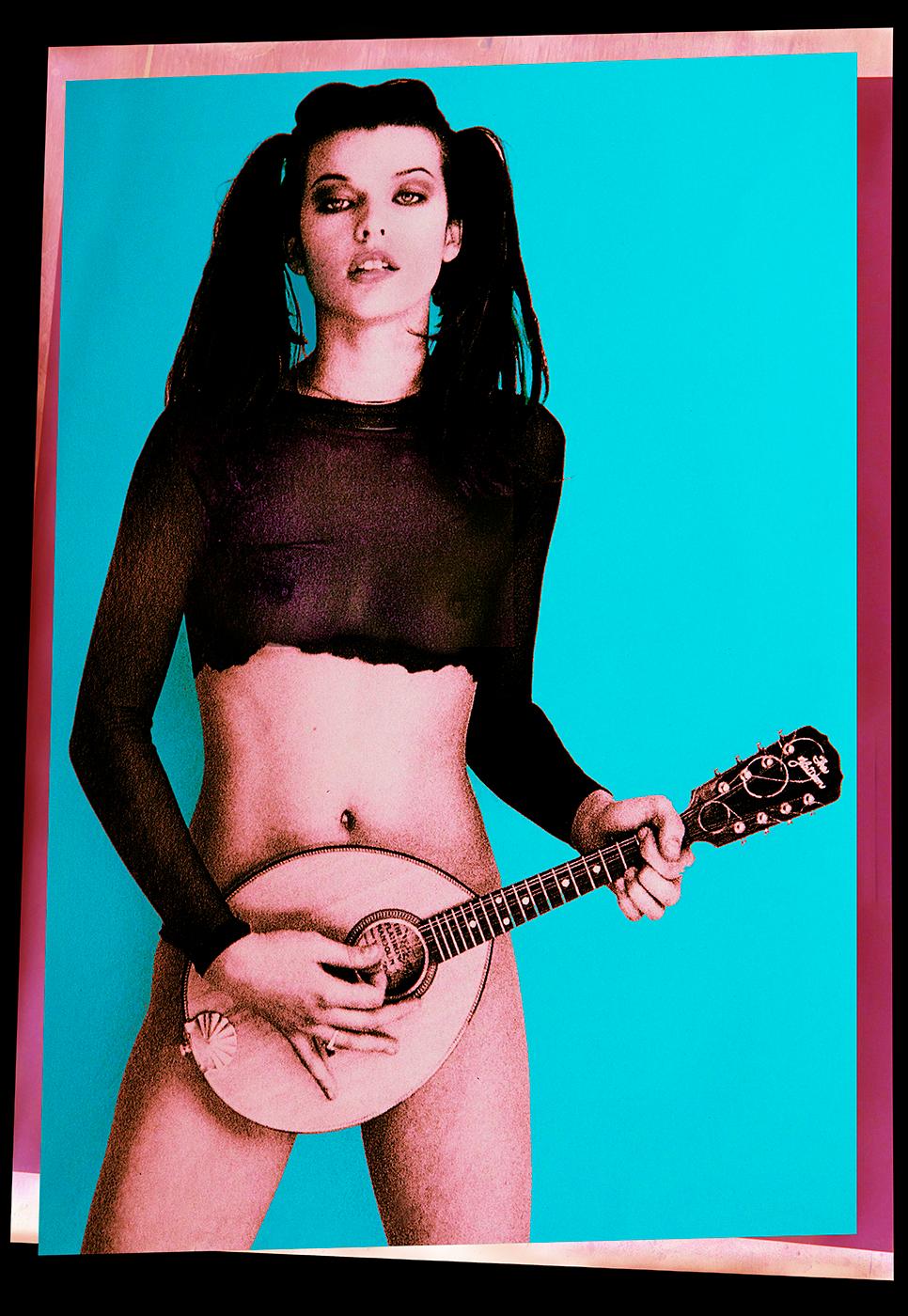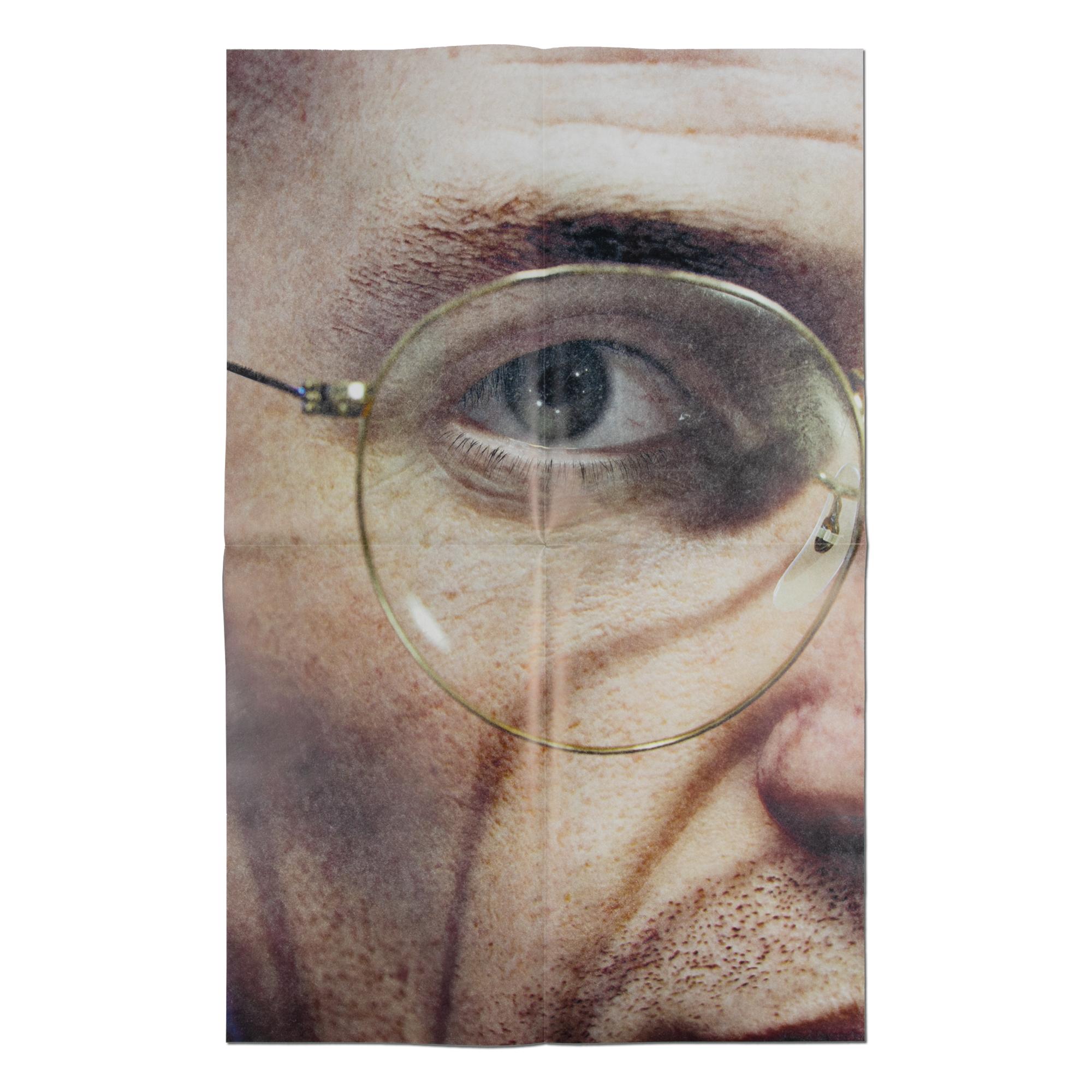Items Similar to Monograph: The Complete Paintings (Hand signed, inscribed by Philip Pearlstein)
Want more images or videos?
Request additional images or videos from the seller
1 of 22
Philip PearlsteinMonograph: The Complete Paintings (Hand signed, inscribed by Philip Pearlstein)1984
1984
About the Item
Philip Pearlstein The Complete Paintings, 1984
Hardback monograph with dust jacket
Hand signed, dated and inscribed to Nadine by Philip Pearlstein
12 × 10 1/2 × 1 3/4 inches
This illustrated 1984 hardback monograph with dust jacket was hand signed for Nadine at the Betty Cuningham Gallery exhibition "Pearlstein New Work" on February 21, 2013.
Book information:
Publisher: ALPINE FINE ARTS COLLECTION, LTD, New York, 1984
Hardback: 372 pages with 120 full color and over 500 black and white illustrations
Publisher's blurb:
Philip Pearlstein grew out of Abstract Expressionism to become one of the most important and innovative artists of the contemporary Realist school. Born in 1924, he studied art at the Carnegie Institute of Technology and received his Masters in art history at New York University. Since the early 1960's he has been constantly developing and refining his style, devoting himself to a truer, more accurate depiction of his subject matter. Twenty years after his switch to realism, one finds Pearlstein more effective than ever, and also more influential. His works can be seen in most of the nation's major museums as well as many of the smaller, regional collections. Pearlstein has long been an advocate of the rights of artists, especially inn matters of copyright and reproduction. He has been a member of numerous panels and committees discussing these issues as well as the importance of realist art in general. Pearlstein's bold honesty, devotion to his artistic principles, and his dedication to the teaching of younger artists have all earned him a place in the history of art.
In 1983-1984, the Milwaukee Art Museum travelled the first major retrospective of Pearlstein's works. Philip Pearlstein includes a text by Russell Bowman, curator of the exhibition, and introduction by Hilton Kramer, former art critic for The New York Times, an essay by art critic Irving Sandler, as well as a complete photographic listing of all known oil paintings by Pearlstein. An important, scholarly book, the definitive text, the 120 full color and over 500 black and white illustrations and the artistic relevance make Philip Pearlstein a major work to anyone interested in contemporary art.
More about Philip Pearlstein:
Philip Pearlstein was born in Pittsburgh, PA, in 1924. In 1941, his junior year in high school, he received his first recognition when awarded first and third prizes in Scholastic Magazine’s 14th National High School Art Exhibition. Upon graduation from high school in 1942, he enrolled in the Carnegie Institute of Technology but the draft limited his attendance to one year. After discharge from the army in 1946, he returned to Carnegie Tech where he received his BFA in 1949. Upon graduation, he moved to New York City where he pursued work in graphic design and received a Master’s degree in art history from New York University in 1955.
Pearlstein worked as a graphic designer for Life Magazine before becoming an instructor at the Pratt Institute, and then a professor at Brooklyn College; he has also served as a visiting artist at several prestigious institutions throughout the country. His work has been exhibited in several solo exhibitions throughout the United States with paintings in the collections of over 70 public art museums. Pearlstein served as a President of the American Academy of Arts and Letters from 2003-2006 and currently lives and works in New York.
“It is what is painted between the outlines that makes the difference between merely competent painting and really meaningful art.”
- Creator:Philip Pearlstein (1924, American)
- Creation Year:1984
- Dimensions:Height: 12 in (30.48 cm)Width: 10.5 in (26.67 cm)Depth: 1.75 in (4.45 cm)
- Medium:
- Movement & Style:
- Period:
- Condition:
- Gallery Location:New York, NY
- Reference Number:1stDibs: LU1745213368122
About the Seller
5.0
Platinum Seller
These expertly vetted sellers are 1stDibs' most experienced sellers and are rated highest by our customers.
Established in 2007
1stDibs seller since 2022
289 sales on 1stDibs
Typical response time: 1 hour
- ShippingRetrieving quote...Ships From: New York, NY
- Return PolicyA return for this item may be initiated within 1 day of delivery.
More From This SellerView All
- Postcard of Phong Bui's portrait of Jasper Johns, hand signed by Jasper JohnsBy Jasper JohnsLocated in New York, NYJasper Johns and Phong Bui Offset lithograph card of portrait of Jasper Johns by Phong Bui (hand signed and dated by Jasper Johns), 2008 Card depicting a portrait of Jasper Johns by ...Category
Early 2000s Realist Portrait Prints
MaterialsPostcard, Lithograph, Offset, Ink
- Poster: Photographs 1970-1990 with Steve Martin (Hand signed by Annie Leibovitz)By Annie LeibovitzLocated in New York, NYAnnie Leibovitz Photographs 1970-1990 (Hand signed by Annie Leibovitz), 1993 Offset lithograph poster (hand signed) Boldly signed in black marker on the front 30 × 24 inches Ansel Adams Center for Photography, San Francisco in collaboration with the National Portrait Gallery, Smithsonian Institution Unframed This offset lithograph poster was published on the occasion of the Annie Leibovitz' 1993 survey exhibition at the Ansel Adams Center for photograph in San Francisco. The photograph of course depicts the actor and renowned art collector Steve Martin in front of a Franz Kline painting entitled Rue, which Martin apparently once owned. Steve Martin was said to have always wanted to be part of the painting; Complete with black brushstrokes on his white suit, Martin realized his dream and posed for Leibowitz in front of Rue. (Of course the irony is that Martin cuts a gleeful, almost clownish pose in front of a painting, Rue, whose very name means sorry and regret. Perhaps Martin will rue the day he sold this Franz Kline!) A companion photo appeared on the cover of Rolling Stone magazine. The Portland Art Museum also exhibited the photo Annie Leibovitz took of Steve Martin in Beverly Hills when he posed for his portrait. A coveted poster when hand signed by Annie Leibovitz Provenance: Collection of former Trustee of the Portland Museum of Art Annie Leibovitz Biography: Born in 1949, Annie Leibovitz graduated from the San Francisco Art Institute in 1971. Photos she took during college while living on a kibbutz in Israel and working to uncover the remains of King Solomon’s Temple helped land her a job at Rolling Stone magazine, where she was quickly named chief photographer. Between photographing John Lennon and documenting the Rolling Stones’ 1975 concert tour, Liebovitz reinforced her reputation as the most prominent celebrity photographer of her generation. In 1983, she moved to Vanity Fair, where she broadened her range of subjects from rock stars to other public figures like the Dalai Lama. In 1991, Leibovitz became only the second living photographer to be featured in an exhibit at the National Portrait Gallery. Overview and Early Life For decades, Annie Leibovitz and her camera have exposed to the public eye subtleties of character in rock stars, politicians, actors, and literary figures that lay beneath their celebrity personae. Her work first fueled the American fascination with rock ’n’ roll dissidents in the 1970s and then, in the 1980s and 1990s, captured the essence of the day’s great cultural icons. Her photographs make plain that, as Leibovitz herself once put it, she was not afraid to fall in love with her subjects. Anna-Lou Leibovitz was born on October 2, 1949, in Westbury, Connecticut. She was the third of six children of Marilyn Leibovitz, a modern dance instructor, and Sam Leibovitz, an air force lieutenant colonel. As the daughter of a career military officer, Leibovitz moved with her family frequently from town to town. The constant relocation fostered strong ties among the six Leibovitz children. Education and Work with Rolling Stone Leibovitz attended the San Francisco Art Institute from 1967 until 1971. She shifted her focus from painting to photography early in her college career. In 1969, she lived on Kibbutz Amir in Israel. The archaeological team on which she worked during her five months in Israel uncovered the remains of King Solomon’s Temple. By the time Leibovitz received her bachelor of fine arts degree in 1971, her photographs of Israel and a picture of the poet Allen Ginsberg at a San Francisco peace march had already landed her a job at the music magazine Rolling Stone. Soon after she was hired, Leibovitz convinced editor Jann Wenner to grant her a breakthrough assignment. Leibovitz flew with Wenner to New York City to interview John Lennon. A photo from that trip adorned the cover of Rolling Stone, the first of dozens Leibovitz would shoot over the course of her career with the music magazine. In 1973, she was named chief photographer. The mid-1970s brought Leibovitz an increasing amount of notoriety and its concomitant tribulations. In 1975, the rock band the Rolling Stones invited Leibovitz to document their six-month concert tour. Living in the world of her subjects, her camera did not shield Leibovitz from the rock ’n’ roll life-style. She began using cocaine on tour and struggled for years afterward to recover. Photography Exhibits and Move to Vanity Fair In 1983, Leibovitz put together her first major exhibit, which led to the publication of her book Annie Leibovitz: Photographs (1983). Her ability to work with her subjects to get beneath the veneer of superficiality that typically characterizes Hollywood paparazzi has reinforced her reputation as the most prominent celebrity photographer of her generation. The rapport Leibovitz develops with her subjects creates an atmosphere in which celebrities will strike the most unconventional of poses and show emotions that other photographers could not evoke. Among her most famous shots are a naked John Lennon curled around a fully clothed Yoko Ono, Bette Midler in a bed of roses, and the Blues Brothers painted blue. In 1983, after more than a decade of photographing such rock ’n’ roll legends as Lennon, Bob Dylan, Stevie Wonder, and Bruce Springsteen, Leibovitz left Rolling Stone for Vanity Fair. This move gave her the opportunity to shoot a broader range of subjects, including the Dalai Lama, Vaclav Havel, and Donald Trump. Her art did not suffer from the change. The American Society of Magazine Photographers selected her as the Photographer of the Year in 1984. Advertising Work, Awards, and Honors In addition to her work for Vanity Fair, Leibovitz became active in advertising photography. In 1986, she was the first photographer ever to be commissioned to design and shoot posters for the World Cup. A campaign she designed for American Express brought Leibovitz a storm of critical acclaim. In 1987, she received the Innovation in Photography Award from the American Society of Magazine Photographers, a Clio Award from Clio Enterprises, and a Campaign of the Decade Award from Advertising Age for the “Portraits” campaign she produced for American Express. Then, in 1990, the International Center of Photography recognized the same work by giving Leibovitz the Infinity Award for applied photography. n 1991, Leibovitz became only the second living photographer to be featured in an exhibit at the National Portrait Gallery in Washington, D.C. She published this retrospective in book form under the title Annie Leibovitz: Photographs, 1970–1990. In anticipation of the centennial Olympic games, Leibovitz spent two years photographing athletes...Category
1990s Realist Figurative Prints
MaterialsInk, Offset, Lithograph
- Phil Limited Edition rubber stamp Portrait of Philip Glass, pencil no. 243/1000By Chuck CloseLocated in New York, NYChuck Close Phil, 1976 Limited Edition Print on Strathmore 3-Ply Paper. Pencil numbered 243/1000 on the verso. Artist's printed copyright name verso. Accompanied by original envelope...Category
1970s Realist Figurative Prints
MaterialsMixed Media, Pencil, Lithograph, Offset
- Monograph: Strangeland (Hand signed, dated and inscribed by Tracey Emin)By Tracey EminLocated in New York, NYTracey Emin Strangeland (Hand signed, dated and inscribed by Tracey Emin), 2005 Hardback monograph with dust jacket (hand signed, dated and inscribed for Ann by Tracey Emin) Hand sig...Category
Early 2000s Pop Art Figurative Prints
MaterialsPaper, Offset, Lithograph, Mixed Media, Ink
- Monograph: Philip Glass Words Without Music (book hand signed by Philip Glass)Located in New York, NYPhilip Glass Words Without Music (hand signed by Philip Glass), 2015 Hardback monograph with dust jacket (hand signed by Philip Glass) Hand signed by Philip Glass on the half title page 9 1/2 × 6 1/2 × 1 1/4 inches Hand signed by Philip Glass on the half title page. Makes an excellent gift! Book information: Publisher: Liveright Publishing Company, 2015 English; Hardcover; 432 pages; 32 pages of photographs Publisher's blurb: The long-awaited memoir by “the most prolific and popular of all contemporary composers” (New York Times). A world-renowned composer of symphonies, operas, and film scores, Philip Glass has, almost single-handedly, crafted the dominant sound of late-twentieth-century classical music. Yet here in Words Without Music, he creates an entirely new and unexpected voice, that of a born storyteller and an acutely insightful chronicler, whose behind-the-scenes recollections allow readers to experience those moments of creative fusion when life so magically merged with art. "If you go to New York City to study music, you'll end up like your uncle Henry," Glass's mother warned her incautious and curious nineteen-year-old son. It was the early summer of 1956, and Ida Glass was concerned that her precocious Philip, already a graduate of the University of Chicago, would end up an itinerant musician, playing in vaudeville houses and dance halls all over the country, just like his cigar-smoking, bantamweight uncle. One could hardly blame Mrs. Glass for worrying that her teenage son would end up as a musical vagabond after initially failing to get into Juilliard. Yet, the transformation of a young man from budding musical prodigy to world-renowned composer is the story of this commanding memoir. From his childhood in post–World War II Baltimore to his student days in Chicago, at Juilliard, and his first journey to Paris, where he studied under the formidable Nadia Boulanger, Glass movingly recalls his early mentors, while reconstructing the places that helped shape his artistic consciousness. From a life-changing trip to India, where he met with gurus and first learned of Gandhi’s Salt March, to the gritty streets of New York in the 1970s, where the composer returned, working day jobs as a furniture mover, cabbie, and an unlicensed plumber, Glass leads the life of a Parisian bohemian artist, only now transported to late-twentieth-century America. Yet even after Glass’s talent was first widely recognized with the sensational premiere of Einstein on the Beach...Category
2010s Contemporary Figurative Prints
MaterialsPaper, Offset, Lithograph, Mixed Media, Ink
- Hardback monograph: George Segal (signed and inscribed by sculptor George Segal)By George SegalLocated in New York, NYGeorge Segal (signed and inscribed by George Segal), 1989 Hardback monograph with dust jacket (signed, dated and inscribed for Tera by George Segal) Warmly signed, dated 3/27/1998 an...Category
1980s Pop Art Figurative Prints
MaterialsInk, Offset, Lithograph, Mixed Media, Paper
You May Also Like
- "Kate Moss. Boyfriends Underpants" Photography 50x40 in Ed. of 20 by Kate GarnerBy Kate GarnerLocated in Culver City, CA"Kate Moss. Boyfriends Underpants" Photography 50x40 in Ed. of 20 by Kate Garner Hahnemuhle fine art archival paper Kate Garner: Seeker, Sage, and Preservationist of Identity A thoughtful selection of Kate Garner’s most pivotal work, showing the arc of identity, and her expression as one of the great masters of fine art photography today. In this collection of works, see rare and seldom viewed images of Kate Moss, Angelina Jolie, David Bowie, FKA Twigs, and more. Kate Garner evolved in the edgy pop-punk heyday of 1980’s London. By the time she was in her early 20s, she was well on her way to becoming one of the most enigmatic fine art photographers of our time. But it didn’t start that way. Until Kate was 19, she had spent most of her time in a tough mining town in the north of England. It was a practical place with practical people that studied practical vocations and couldn't afford to let themselves dream too much. Growing up, Kate had expected a similar existence, but it was never what she had envisioned. Like much of her class, she attended formal trade education at the local vocational college after graduating secondary school and spending a year hitch-hiking from England, through Europe, Afghanistan, Iran, Pakistan to India Garner came back from India and started to study commercial photography, and in Northern England, that meant--pots and pans. But, Kate knew she was different and would often take herself down into the thriving metropolis of London to see and experience the vibrant Mecca of arts and creatives. Her creative path took a pivotal point when her wanderings introduced her to the Blitz Kids. The art students and teenage squatters took her in, and It wasn’t long before she began shooting the streets with London’s party scene artisans and gender-bending pioneers. Working with John Galliano, Stephen Jones, Boy George, and later even David Bowie--Kate became fully immersed in the New Romantic...Category
20th Century Contemporary Figurative Prints
MaterialsArchival Ink, Archival Paper
- "Bowery Boys" Photograph 40" x 56" inch Edition 1/1 by Kate GarnerBy Kate GarnerLocated in Culver City, CA"Bowery Boys" Photograph 40" x 56" inch Edition 1/1 by Kate Garner Hahnemuhle fine art archival paper Kate Garner: Seeker, Sage, and Preservationist of Identity A thoughtful selec...Category
20th Century Contemporary Figurative Prints
MaterialsArchival Ink, Archival Paper
- "Milla pinkyellow Uke" Photography 29" × 20" in Edition of 20 by Kate GarnerBy Kate GarnerLocated in Culver City, CA"Milla pinkyellow Uke" Photography 29" × 20" in Edition of 20 by Kate Garner Hahnemuhle fine art archival paper Kate Garner: Seeker, Sage, and Preservationist of Identity A thoughtful selection of Kate Garner’s most pivotal work, showing the arc of identity, and her expression as one of the great masters of fine art photography today. In this collection of works, see rare and seldom viewed images of Kate Moss, Angelina Jolie, David Bowie, FKA Twigs, and more. Kate Garner evolved in the edgy pop-punk heyday of 1980’s London. By the time she was in her early 20s, she was well on her way to becoming one of the most enigmatic fine art photographers of our time. But it didn’t start that way. Until Kate was 19, she had spent most of her time in a tough mining town in the north of England. It was a practical place with practical people that studied practical vocations and couldn't afford to let themselves dream too much. Growing up, Kate had expected a similar existence, but it was never what she had envisioned. Like much of her class, she attended formal trade education at the local vocational college after graduating secondary school and spending a year hitch-hiking from England, through Europe, Afghanistan, Iran, Pakistan to India Garner came back from India and started to study commercial photography, and in Northern England, that meant--pots and pans. But, Kate knew she was different and would often take herself down into the thriving metropolis of London to see and experience the vibrant Mecca of arts and creatives. Her creative path took a pivotal point when her wanderings introduced her to the Blitz Kids. The art students and teenage squatters took her in, and It wasn’t long before she began shooting the streets with London’s party scene artisans and gender-bending pioneers. Working with John Galliano, Stephen Jones, Boy George, and later even David Bowie--Kate became fully immersed in the New Romantic...Category
21st Century and Contemporary Contemporary Figurative Prints
MaterialsArchival Ink, Archival Paper
- "Milla pink Uke" Photography 29" × 20" in Edition of 20 by Kate GarnerBy Kate GarnerLocated in Culver City, CA"Milla pink Uke" Photography 29" × 20" in Edition of 20 by Kate Garner Hahnemuhle fine art archival paper Kate Garner: Seeker, Sage, and Preservationist of Identity A thoughtful selection of Kate Garner’s most pivotal work, showing the arc of identity, and her expression as one of the great masters of fine art photography today. In this collection of works, see rare and seldom viewed images of Kate Moss, Angelina Jolie, David Bowie, FKA Twigs, and more. Kate Garner evolved in the edgy pop-punk heyday of 1980’s London. By the time she was in her early 20s, she was well on her way to becoming one of the most enigmatic fine art photographers of our time. But it didn’t start that way. Until Kate was 19, she had spent most of her time in a tough mining town in the north of England. It was a practical place with practical people that studied practical vocations and couldn't afford to let themselves dream too much. Growing up, Kate had expected a similar existence, but it was never what she had envisioned. Like much of her class, she attended formal trade education at the local vocational college after graduating secondary school and spending a year hitch-hiking from England, through Europe, Afghanistan, Iran, Pakistan to India Garner came back from India and started to study commercial photography, and in Northern England, that meant--pots and pans. But, Kate knew she was different and would often take herself down into the thriving metropolis of London to see and experience the vibrant Mecca of arts and creatives. Her creative path took a pivotal point when her wanderings introduced her to the Blitz Kids. The art students and teenage squatters took her in, and It wasn’t long before she began shooting the streets with London’s party scene artisans and gender-bending pioneers. Working with John Galliano, Stephen Jones, Boy George, and later even David Bowie--Kate became fully immersed in the New Romantic...Category
21st Century and Contemporary Contemporary Figurative Prints
MaterialsArchival Paper, Archival Ink
- "Milla pink blue Uke" Photography 29" × 20" in Edition of 20 by Kate GarnerBy Kate GarnerLocated in Culver City, CA"Milla pink blue Uke" Photography 29" × 20" in Edition of 20 by Kate Garner Hahnemuhle fine art archival paper Kate Garner: Seeker, Sage, and Preservationist of Identity A thought...Category
21st Century and Contemporary Contemporary Figurative Prints
MaterialsArchival Ink, Archival Paper
- Ed Atkins, The Worm - Contemporary Photography, Signed PrintLocated in Hamburg, DEEd Atkins (British, b. 1982) The Worm, 2021 Medium: Offset lithograph (folded twice, as issued) Dimensions: 28 3/10 × 18 1/2 in (72 × 47 cm) Edition of 30: Hand-signed and numbered C...Category
21st Century and Contemporary Contemporary Figurative Prints
MaterialsOffset
Recently Viewed
View AllMore Ways To Browse
Bruno Emiro Callegari On Sale
Called By Schwung
Carlo Cesio
Chagall David And Goliath
Chock Full O Nuts Vintage
Christine Rosamond
Claude Weisbuch On Sale
Consuelo De Saint Exupery
Cornetto Poster
Dali Cavalier Triomphant
Dali Heterosexual
Dali Illustrates Casanova
Dali Mosed
Disparate De Miedo
Edolo Masci
Edra Soto
Engraved Copper Fire Screen
Erik Desmazieres On Sale
